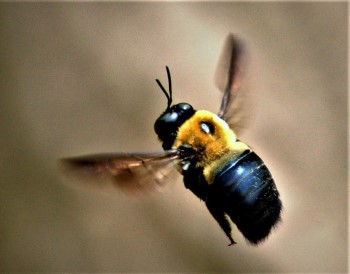CARPENTER BEES LONG ISLAND, NEW YORK
Carpenter bees are so-called because of their habit of excavating tunnels in wood with their powerful jaws. These large black and yellow bees are frequently seen in the spring hovering around the eaves, the underside of a deck or porch railing of Long Island homes. Carpenter bees are often mistaken for bumblebees but generally have a hairless, shiny abdomen. Unlike honeybees and bumblebees, carpenter bees are not social insects and, therefore, don't exist in a hierarchically structured colony. These solitary bees are early morning foragers that are excellent pollinators of flowers, eggplant, tomato, and other vegetables. Using their powerful jaws, they create perfectly round holes in wood to raise their offspring. A female carpenter bee will bore five or six chambers within the wood tunnel to house individual eggs. Carpenter bees will produce mounds of sawdust as they bore holes about 1/2" in diameter through the wood. The wood-boring bees will make their homes in weather-beaten wood, usually softer varieties such as pine, redwood, cedar, and cypress. The carpenter bee nest will have a single entrance and many adjacent tunnels. Considerable damage can result when the same pieces of wood are infested with carpenter bees year after year. Woodpeckers eat carpenter bees, as do several species of birds. Woodpeckers will drill holes along the carpenter bee tunnels to feed on the bee larvae, resulting in more extensive damage.
CARPENTER BEE LIFE CYCLE & REPRODUCTION NASSAU COUNTY, LONG ISLAND
Carpenter bees are long-lived, having a life expectancy of three years. There usually are five to six brood chambers provisioned with a portion of bee bread, which serves as food for the developing larvae. A female carpenter bee deposits an egg on the food supply, and each chamber is sealed off. Carpenter bees have four life stages: egg, larval, pupal, and adult. It takes roughly seven weeks for a carpenter bee to reach adulthood, but maturity duration may vary contingent upon the temperature and other environmental factors. Newly developed carpenter bee adults typically remain in their wood galleries for several weeks and exit their brood cells in April or May. The carpenter bees mate and will feed on pollen and nectar. The carpenter bees will return to their wood tunnel brood nests in the fall, where they will hibernate and arise the following spring. Female carpenter bees have one litter of offspring on Long Island, but they may have two or more generations per year in southern states.









